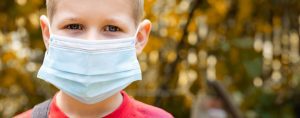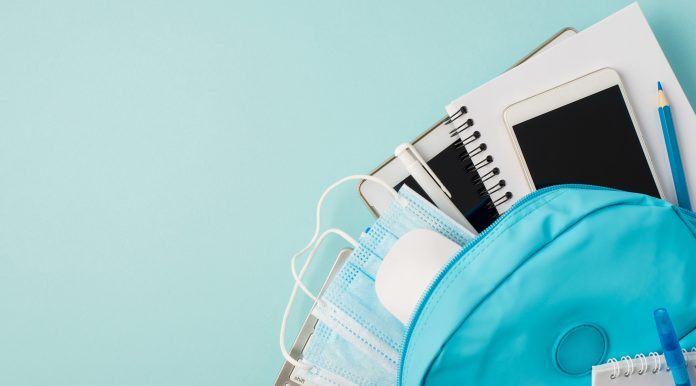ELLEN GELLER KAMARAS
At the time of writing, the COVID-19 situation, and the situation in the world in general, seem to be changing so rapidly it is hard to predict with certainty what even the next few weeks will bring. The facts noted in this article and the opinions professed are accurate in the moment. By the time of publication, you may already see things have changed. We are all praying for an end to the pandemic and a return to life as normal. As it stands, after a year of on-and-off Zoom learning, schools across the country are mandating in-person learning this coming school year.
Mixed Reactions to the Reopening of Schools
Students, teachers, and parents are enthusiastic about a full reopening of schools for the 2021-2022 school year. However, returning to school for in-person learning may also be causing some nervousness about being in a more structured setting and processing new rules and relationships.
While we look forward to connecting with classmates and colleagues in person, we acknowledge that the COVID-19 environment is constantly changing. Normal as we knew it before the pandemic has changed. We have become accustomed to living a pandemic life.
A New Focus
A year ago, the million-dollar question was: can our children return to school safely? The COVID-19 environment was unpredictable, and people had not been vaccinated. The Covid situation has improved tremendously, and the vaccine rollout continues, but we are not yet out of the woods. We must be prepared for disruptions to in-person school if the number of COVID-19 cases surges.
This year, public officials are focusing on recovery and healing, bringing staff and students back to work and school, and keeping them safe. Some educators call it a resilient reopening. Why resilient? Practicing resilience is what got us successfully through the past 17 months and will continue to enable us to live as normal a life as we can. We lived with uncertainty and turned difficult situations into opportunities.
In July, NYC Mayor de Blasio announced that NYC is back and fully reopened. Sixty-six percent of the city’s adult population was fully vaccinated as of early August.
NJ Governor Murphy is also proud that NJ’s full vaccinated rate reached 58% but sounded the alarm on the “pandemic of the unvaccinated.”
Delta Variant Changes the Game
The Delta variant has thrown us a curveball and government and health officials are laser focused on fighting it.
On July 9th, the Centers for Disease Control and Prevention announced that only unvaccinated staff and students need to wear masks in schools. Eighteen days later, on July 27th, the CDC reversed course, and now recommends that all students and staff mask up, irrespective of vaccination status.
The updated guidance advises wearing a mask in indoor public settings in areas of substantial and high transmission.
Why the Reversal?
There is clear and mounting evidence that breakthrough COVID-19 infections can arise in fully vaccinated individuals. The good news is that if COVID-19 infection does occur, it is much less likely to cause serious illness or death for those who are vaccinated.
Moreover, officials are gratified that schools have not been a major cause of Covid spreading, which they attribute to the combination of prevention measures that have been in place and have proved effective.
A key takeaway from the CDC updated guidance is that students benefit from in-person learning, and safely returning to in-person instruction is a priority.
School policies related to masking and COVID-19 protocols are determined by individual states.
Most state/local health officials stopped short of mandating indoor mask wearing. In vicinities where COVID-19 is spreading, officials are promoting masking in public indoor settings as an additional defense against the Delta variant.

Staying Calm and Preparing Kids for Returning to School
First, we should acknowledge and thank both our private and public officials for keeping our children’s health their number one priority.
Mayor De Blasio is promoting vaccination as the key public intervention to keep New Yorkers safe. He cites evidence that masking, while helpful, does not provide as effective protection as the vaccine does.
NYC and NJ public schools will require students and staff to wear masks inside of school buildings, regardless of vaccination status.
This morning, however, I heard a quote from former CDC Director Redfield explaining, that “masking is not a one-size-fits-all question.”
Yes, many of us will be disappointed if asked to return to wearing masks indoors. However, it may only be for a short period. As Dr. Brenda Phillips, an emergency management and disaster recovery expert, so aptly put it, “We can do this a bit longer, if necessary, to help the people around us. It’s our responsibility as humans to take care of each other.”
This particularly rings true for us as Jews. We are committed to pikuach nefesh, the preservation of human life and to the value of taking responsibility for others as well as ourselves.
Let’s follow the science and stay connected with our children’s school administration leaders who are monitoring the COVID-19 situation carefully.
The yeshivot I surveyed in the Brooklyn and the Jersey Shore communities are planning on a regular in-person school year. At the time I contacted these yeshivot, mandated masking for indoor spaces had not been adopted.
The administrators will continue to scrutinize the fluid Covid situation, and the health and safety of the students and staff remain their top priority. They will respond appropriately in accordance with the guidance of their medical teams.
Are You Ready to Do This?
Educators are advocating that we prepare our children for school academically, socially, and emotionally. The social and emotional aspects are being given additional emphasis this year because of the traumatic effects of the COVID-19 pandemic on children. We need to help our children unpack numerous complex emotions as they get ready to return to school.
Nothing beats being in a classroom. Over 50 percent of public-school K-12 teachers reported that the pandemic caused a “significant” learning loss for students, both academically and in their social-emotional progress.
Dust Off Your BTS Toolbox and Get Positive
Model a positive mindset about the return to school and encourage your children to think about what they can look forward to. Turn that frown upside down. Take time to express gratitude at the dinner table, especially on Shabbat. We overcame challenges, learned new skills, and faced adversity with grace, determination, and even humor.
Arrange a Family Meeting
Carve out time for a special outing or a trip to a fun venue before school starts. Discuss how everyone is feeling about returning to school. That includes moms and dads too who may be returning to the office and need to plan and transition again for carpools, meal planning, and more. Tease out significant concerns.
In pre-pandemic times, children experienced anxiety, trepidation, or stress about starting a new grade or a new school. The pandemic added the fear of getting sick, along with the usual back-to-school anxiety.
The students who opted for Zoom or hybrid learning last year, may need assistance adjusting to being in school full time. They may experience separation anxiety over leaving their families after over a year of togetherness and may feel apprehensive about leaving their safe harbor from the pandemic.
They may be worried about navigating in-person relationships and a more controlled setting in school.
Consider how children will adapt to their parents returning to the workplace. Nannies or grandparents may be stepping in again after school to take children off the bus and settle them in for a snack and homework.
Communicate
Explain to your kids that you are always there for them and that they have your unconditional support.
Communicate hope and confidence but avoid making promises you cannot keep. Encourage your children to be flexible, and to expect changes, as the COVID-19 world is still unpredictable.
Listen, Listen, and Listen
If ever there was a time to practice my coaching professor’s mantra, WAIT, “Why am I talking?” the time is now.
Practice active listening and validate your children’s feelings, fears, and anxieties. Listen to what they are saying and not saying (their unspoken feelings). Help them to articulate their emotions.
Supplies
Are you all set with school supplies, uniforms, and gear?
Our kids feel happy, confident, and prepared when returning to school when they have the basics. Who does not enjoy a new pack of Crayola crayons or a new binder?
Give your children skin in the game by having them shop with you in person or online, within budget guidelines, of course.
New Beginnings
Rosh Hashanah and the new school year are about new beginnings, affording parents and children alike the opportunity to take a fresh look at themselves.
Help your children identify their unique special spark, their talents, strengths, and passions.
Encourage your children to pick a new mitzvah to incorporate into their lives. Highlight middot tovot, and kindness to others, above all to new classmates.
Wishing you lots of good health, mazal, and a shana tova!
Ellen Geller Kamaras, CPA/MBA, is an International Coach Federation (ICF) Associate Certified Coach. Her coaching specialties include life, career, and dating coaching. Ellen works part-time as an entitlement specialist at Ohel Children’s Home and Family Services. She can be contacted at ellen@lifecoachellen.com (www.lifecoachellen.com).



